"I'm not freakin' traveling just to see crop circles!", hubby's voice was stern.
Aaand initiating facepalm in 3.. 2... 1.
He clearly didn't spend his younger years watching Space Sheriff Shaider.
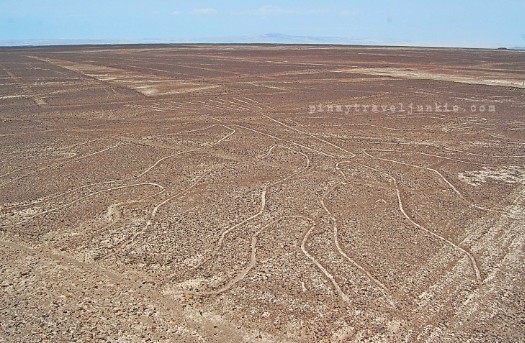
Fast forward to January, on day 213 of our 2011-2012 round-the-world trip, this memory made me burst out laughing at the backseat while we were cruising the Pan-American Highway. Hubby probably wondered what it's about but I kept it to myself. We chose to hire a car and hang onto a guided tour's wing because Luna was still recovering from cough and colds — which she caught in Ica a few days prior just before we watched wildlife on Islas Ballestas and trudged on the beautifully bleak Paracas National Reserve.
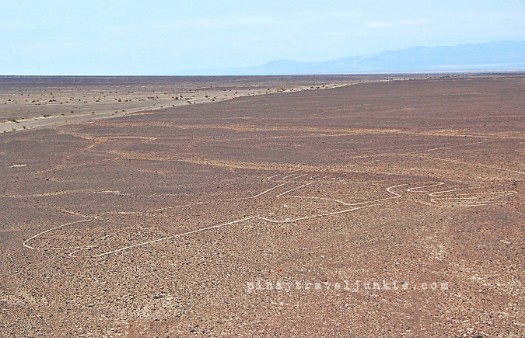
Besides joining a group tour, the other two options to see the Nazca Lines are: (A) Take the collectivo from Nazca town and (B) Fly aboard a Cessna plane. The problem with option A is, it may take forever and a day to catch another collectivo or bus going back to town. With a sick 1 year 4 month-old Luna, this option evidently didn't sound appealing. Hitchhiking is relatively safe in the region but waiting for someone willing to pick you up may take ages too.
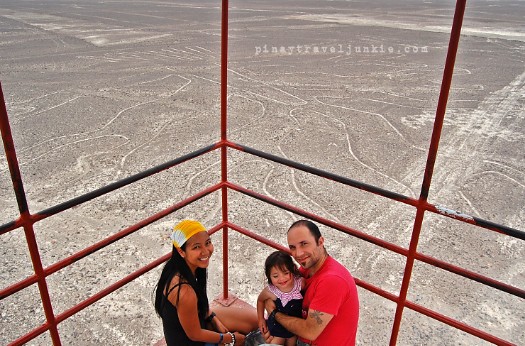
As for option B, well... Aside from being pricey, a Google search of the keywords "Cessna flight Nazca lines" will lead you to an article about tourists being killed in a plane crash. Sure accidents seem rare, but with a toddler we simply couldn't take the risk. So the tour that we arranged with the help of our guesthouse was our best option.

Unfortunately, the tour has its disadvantages too. Compared to taking public transport, booking a tour meant shelling out more dibs, especially cause we weren't able find someone else to share the car with. Also, the Mirador Observation Platform only lets visitors see three geoglyphs. Just so you know, the UNESCO World Heritage Site encompasses almost 500 square kilometers of the Nazca Desert. So yeah, flying is your only way to see the whole shebang. Unless a complex network of zip-lines are built over 'em. Okay, that's a silly joke. Sorry for even putting the idea into the universe.
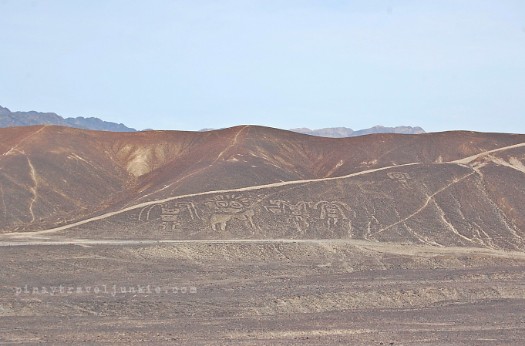
Looking like a tribal version of Family Stickers (yah know, those stick figures you see on cars) to me.

Guide-slash-driver told the fam to pose like so along the Pan-American Highway even with a bus hurtling towards us from behind and the front!
Unfortunately, the tour has its disadvantages too. Compared to taking public transport, booking a tour meant shelling out more dibs, especially cause we weren't able find someone else to share the car with. Also, the Mirador Observation Platform only lets visitors see three geoglyphs. Just so you know, the UNESCO World Heritage Site encompasses almost 500 square kilometers of the Nazca Desert. So yeah, flying is your only way to see the whole shebang. Unless a complex network of zip-lines are built over 'em. Okay, that's a silly joke. Sorry for even putting the idea into the universe.

The drive from Nazca town to Mirador Observation Tower took about half an hour. A climb up the tower costs just 1 Peruvian nuevo sol and should be an easy task unless one has a serious case of acrophobia. The three geoglyphs that can be seen from the tower are The Hands, The Tree, and The Lizard (or sometimes called The Reptile). The Pan-American highway, the world's longest "motorable road" according to Guinness World Records (travels through 18 countries in the Americas), cuts through the tail of The Poor Lizard.
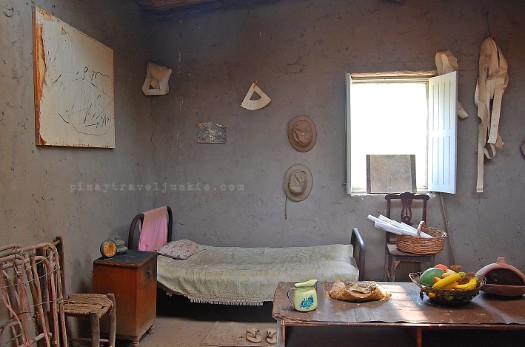
Maria Reiche's old home turned into a museum.

I can imagine how mind-boggling the lines are from a plane. From the observation tower however, the lines did not blow us away perhaps because — save for the uber long straight lines — the shallow trenches (like, 10-15 cm shallow) seemed uncomplicated to make. The lines are formed by removing rust-colored rocks on the surface of the desert to reveal a much lighter shade of earth. And that's... Basically it. How it lasted for more than a thousand years (possibly longer), Mother Nature's responsible for that. These lines have been preserved for such time because it's practically windless in this arid plateau.

Ol' Kombi at Maria Reiche's Museum.
And so what are the Nazca Lines for? Now that's a mystery. Archaeologists, anthropologists and a lot of other ists tried to interpret the lines. One of which is Maria Reiche, a German mathematician and archaeologist who dedicated almost half of her life studying and fighting to preserve them. After visiting two observation towers (the second one's a bit meh), we were taken to her old home that now serves as a museum. Some of her work tools, maps, didactic (dida-huwat?!) scale models, photos are on display. And a wax figure of her sitting behind — presumably her old desk — which totally gave me goosies. She's buried in the garden, beside her sister Renata.

If you think I'll be discussing about the different theories behind the Nazca Lines, well, I'm telling you I'd rather decipher this Georgian kids' show Luna's watching (we're currently in Tbilisi, Georgia). Or I'll start talking about aliens. If you're feeling really slothful to look it up, to put it simply, most of the theories are related to astronomy. And I believe none of which weighs heavier than the other.
It's an open case 'til this very day.
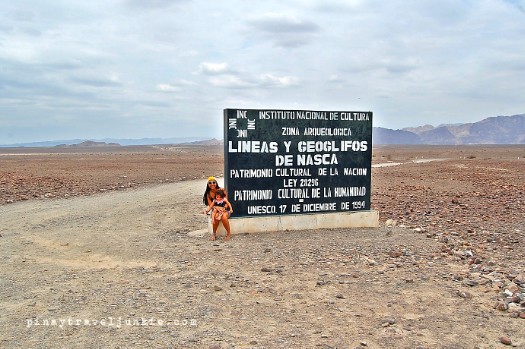
The Nazca Lines have certainly made a lot of ists scratch their heads. But yo, how the hubby initially thought that those lines are crop circles... That's a mystery of life.
Round-The-World 2011-2012, Peru Leg:
Paracas National Reserve, Peru: Images Of A Desolate Beauty
Islas Ballestas, Paracas,Peru: Penguins In The Wild
Huaca Pucllana, Lima, Peru: The Ruins And The Red Balloon
El Zaguan B&B, Lima, Peru
ShareTweet
Round-The-World 2011-2012, Peru Leg:
Paracas National Reserve, Peru: Images Of A Desolate Beauty
Islas Ballestas, Paracas,Peru: Penguins In The Wild
Huaca Pucllana, Lima, Peru: The Ruins And The Red Balloon
El Zaguan B&B, Lima, Peru
This page was viewed times.

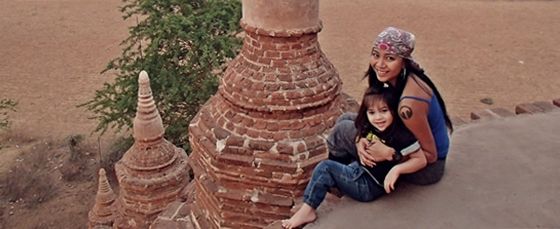

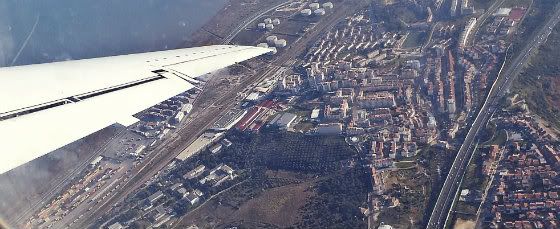

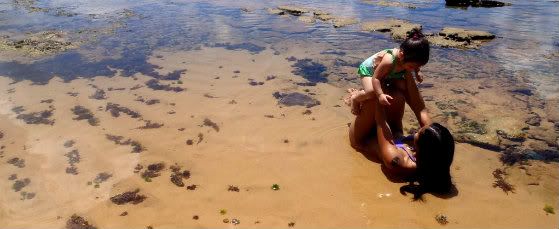













14 comments:
June 9, 2013 at 8:21 AM
I am convinced without a shadow of a doubt that this is the way of Aliens from another planet to communicate with us.
June 9, 2013 at 10:30 PM
OMG Luna already knows how to smile like Gay Emami at that early age hahahahha
June 9, 2013 at 11:27 PM
Hahaha! Manang mana.
June 11, 2013 at 7:22 AM
I agree with Roy Alvarez ^^ this has extraterrestrial written all over it.
Trust no one Emami! #xfiles
June 11, 2013 at 7:54 AM
I was amazed of the place!
June 11, 2013 at 3:53 PM
Ehem, what makes you think I'm human? #meninblack
June 12, 2013 at 9:30 AM
"I'm not freakin' traveling just to see crop circles!"
LOL.
So you guys DO argue about traveling after all (I never heard it much in this blog, nor thought it was possible with how Shervin, as you say, has that otherworldly patience.)
Those lines are out-of-this-world amazing.
By the way, I have always wondered what camera you guys are using. I've never seen a photo of you with a ginormous DSLR, so I'm kind of assuming it's a digicam? Reason I asked is that your photos are always so vivid, vibrant and wide-angled, pretty much like it was taken with a DSLR. Would like to snag me one of those if it doesn't cost an arm and a leg :)
June 12, 2013 at 11:55 AM
This one is great. Nazca lines in Peru is worth exploring. It's so beautiful, amazing!
June 13, 2013 at 12:13 AM
Oh yesss! We argue a lot, actually. But only small arguments. And we usually makeup before the day ends.
I use a D40 (it's not very ginormous compared to others), had it for 4 years now. Photos on the blog posts though are a combination of SLR and P&S shots. It's useful to have a waterproof P&S, especially cause Luna uses it! LOL.
June 13, 2013 at 6:09 AM
Aah. That's a revelation :)
Thank you, will look that up. We are Canon fans 'ere but your shots are much more beautiful and sharper than ours:) Otherwise, my husband has a GoPro Hero 2, but I'm not so keen on using it. Was actually thinking of getting a Lumix or Olympus Tough for underwater/ outdoor P&S (Sorry, nagkwento na eh no?LOL).
Aba, si Luna, pumipichur na rin! Alam na! Hehe.
June 13, 2013 at 4:57 PM
Ahahaha! We got an Olympus Tough, mukhang tough naman sya. Pero di masyadong sharp ang photos, so that's when the tweaking comes in ;-) We wanna have a GoPro too for videos but then Olympus takes very good videos so medyo pinagiisipan pa namin.
June 13, 2013 at 5:10 PM
I did get similar reviews on the Olympus Tough - great video-wise, but photos, not as good daw. But very tough nga daw even when maiwan sa snow. Kaya medyo isip pa din. GoPro's excellent for outdoor sports! Husband uses it for MTB, spelunking and swimming. Malinaw. But picture, medyo crappy lalo pag underwater. Magastos rin, you have to buy a separate lens pa to view the pictures, and last time I asked it's around P4,000-on top of the unit! Kaya mini-mini-my-ni-mo kami pag kukuha ng pic. LOL.
Ayan talagang nagkuwento na ko. Sorry naman.
June 13, 2013 at 8:38 PM
Onga, parang ang mahal ng accessories ni GoPro. Ako rin, isip isip muna. Hihi. But it seems like it's the right gadget for your hubby, so oks na rin :)
June 17, 2013 at 11:22 PM
The most memorable figure here was the hummingbird from Shaider! Of course these Nazca lines brings so much memories of that TV Series. Astig nakita mo na ang Nazca Lines. For me, I think why those figures were there was because it was drawn by early people in that place that amazed them and if astronomy related then, those could be star constellations. 'Loved the line - "Time Space Warp, ngayon din!"
Post a Comment